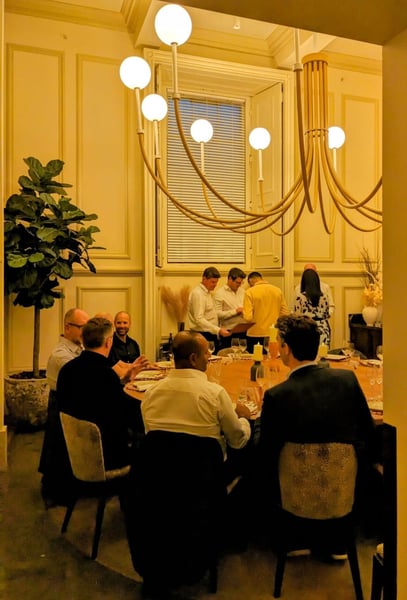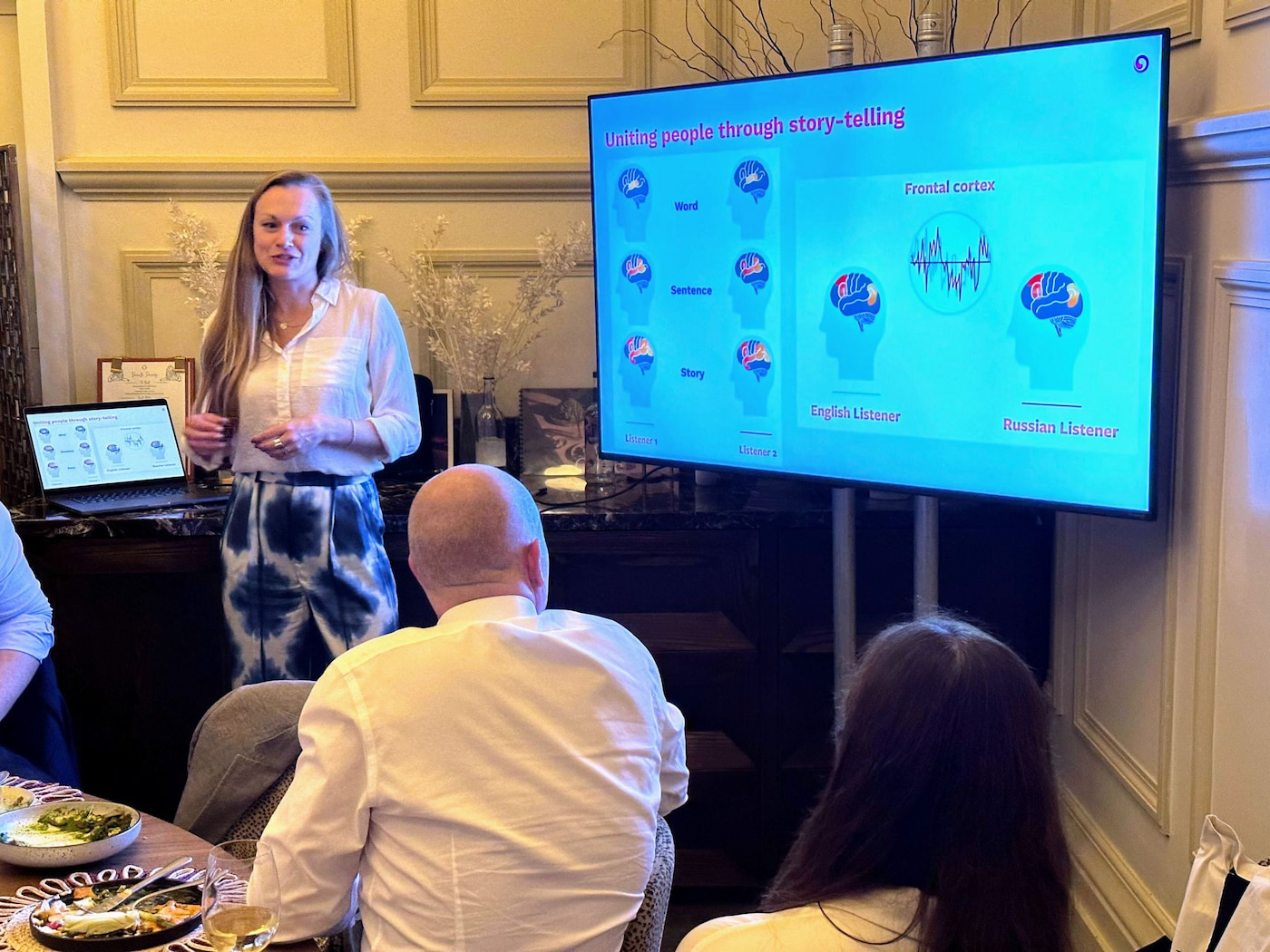Facing the future together- how to unite your team in times of change
Here at Daemon, we don’t just want to be known for our engineering skills. We want to be leaders in uniting teams, and this is as much about listening as it is about speaking. That’s why we recently brought together some of the industry’s most prominent CTO’s and other tech leaders for an evening of food, drinks and frank discussion.
The theme was Uniting People During Change, and our aim was to answer one of the most pressing questions of our time- how can a business embrace change while maintaining a sense of unity and cohesion? The ideas (and the wine) flowed freely, and we left feeling energised. Here’s a look at what we learned, and what it means for the future of Daemon.
Setting the stage for inspiration
The evening began with a presentation from Fran Knight, a Daemon consultant with a passion for neuroscience. She gave a fascinating explanation of the ways in which human brain frequencies can align during a shared experience, capturing the room’s attention and setting the perfect tone for the rest of the event. As one Daemonite explained:
“Fran’s presentation gave us a lot of food for thought. It offered genuinely new insights and things that we can build on as a company, especially when it comes to engaging with customers.”
With everyone fed and watered, we moved on to the serious business of the evening. We held a series of facilitated discussions, all designed to help us answer the big question of the night- how can we maintain unity during times of change?
Defining change
Before we could discuss change, we wanted to agree on the meaning of the word. This was more complicated than it sounds. As the first round of discussions began, it became clear that everyone had their own definition in mind:
- Some were thinking in terms of external change, and the ways in which businesses can respond.
- Others were focused on the kinds of proactive changes that businesses can make in anticipation of future conditions.
In the end, we settled on a compromise- change can be reactive or proactive, but it’s always essential for survival.
This was illustrated by a cautionary tale about Blockbuster and its failure to adapt to the age of streaming. Despite dominating the market in the early 2000s, the company made a critical error when it turned down the opportunity to buy Netflix. There is a lesson here for any business. No matter how well you’re doing in the present, failure to adapt can bring it all crashing down.
Facilitating change
With everyone in agreement about the importance of change, discussion turned to more practical matters. How can we facilitate change, and how can ensure that changes are meaningful and long-lasting?
This generated a lively debate. Once again, two main schools of thought emerged:
- Some argued that change is only possible when everyone is united behind a vision.
- Others believed that, in times of crisis, it may be necessary to enforce top-down change before reaching a company-wide consensus.
This was perhaps the most polarised debate of the night. Some argued that swift, brutal change is necessary in times of crisis. Some even suggested that periods of crisis could be used to drive through changes that would otherwise be considered too radical.
Others saw things differently. They argued that forcing through changes without a consensus might work in the short-term, but it will leave employees feeling disconnected and resentful. It’s not always easy to get everyone on board, but it means that changes are likely to be embraced to a much greater extent.
The importance of strong leadership
Despite these differences of opinion, everyone agreed on one thing. You may not be able to unite an entire company behind a vision for change, but you must ensure that its leaders are pulling in the same direction.
This led to a discussion about the crucial role of middle management. While a vision may be set by those at the top, it’s those in the middle that have to make these changes work. Middle management are often criticised for getting in the way of change but, as one attendee explained, nothing could be further from the truth:
“Middle management are often seen as resistant to change. In fact, they’re the ones who make it happen. They have to deal with the hopes and fears of employees on one side, and the bright ideas of senior people on the other. It’s extremely difficult to make changes without the buy-in of both groups, so this role is crucial.”
Follow us on LinkedIn for the latest Daemon news
Don’t lose sight of your values
As the evening drew to a close, conversation moved from the practical to the ideological. It was decided that, if a company’s values are solid, it can experience any amount of change without losing its original character. Making this happen is a two part process:
- Leaders need to make their values crystal clear.
- Every employee must understand not just their individual objectives, but the overall mission of the business.
There was a lot of discussion about the best way to achieve this clarity of vision. Several attendees stressed the importance of decentralised management. They argued that, by bringing decision making closer to original data sources, a company is more likely to set realistic and workable goals.
Several people also brought up the importance of storytelling in facilitating change, arguing that leaders must appeal to their employee’s emotions as well as their sense of logic. A good story is the key to this, as it allows you to frame changes as part of a movement. This creates a sense of purpose, encouraging a greater degree of buy-in from those experiencing change.
Read more about the importance of vision at Daemon
Supporting you every step of the way
 We were never going to settle this issue in one evening, but we definitely left feeling optimistic. We didn’t always agree on the best ways to facilitate change, or even on the definition of change itself, but everyone was certain of one thing- change is a fact of life, and businesses must be ready to adapt. One attendee summed this up perfectly:
We were never going to settle this issue in one evening, but we definitely left feeling optimistic. We didn’t always agree on the best ways to facilitate change, or even on the definition of change itself, but everyone was certain of one thing- change is a fact of life, and businesses must be ready to adapt. One attendee summed this up perfectly:
“Change is definitely ramping up. The number and frequency of seismic events are increasing, and the need to respond quickly will be a function of successful organisations in the future. If companies want to survive, they need to build a culture that is amenable to change.”
This is where we can help.
As Digital Transformation consultants, we have an unusual relationship to change. Our business is as vulnerable to change as any other, but it’s also our job to drive change in other companies. If we've learned one thing over the years, it’s the importance of doing this in a way that is sensitive to the needs and concerns of our customers.
We don’t want to dictate change from above. We want to agree on a shared vision and then give you the tools to make it a reality. With this approach, we can drive meaningful change without leaving anyone behind. If you’re a tech leader and would like to know more, or be part of these conversations, let us know!

